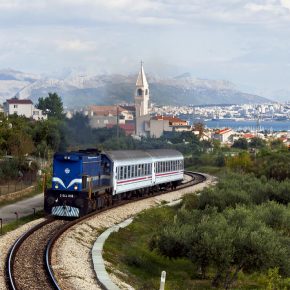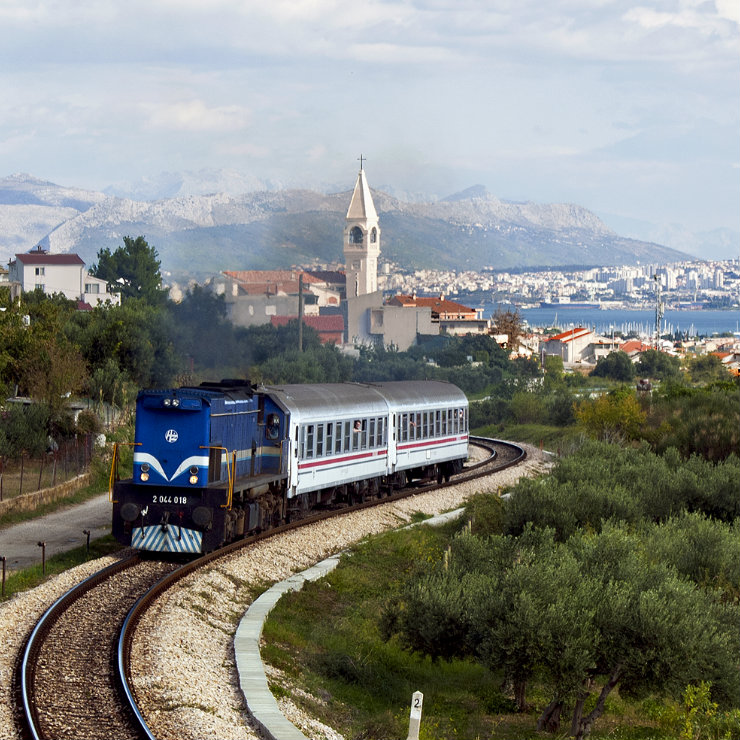
Split, Croatia (Istvan David, CC BY-NC-ND)
Freight carriers note a steady increase in the volume of goods transported, which for the Q2’18 was higher by 12 per cent compared to the same period of 2017, and 19 per cent higher compared to the previous quarter. Although the Q2 saw a slight decrease in total ton-kilometers by 1.2 per cent, new carriers continued to grow and achieved 44 per cent more ton-kilometers compared to the same period of 2017. Train kilometers remained on the level of the Q2’17, but they increased by 3 per cent compared to the Q1’18.
The development of railway infrastructure and the increase of passenger and freight transport are key for Croatian economic development. This year is important for Croatia because EU institutions are currently discussing the EU budget for the period 2021-2027. These debates will determine the financial framework and the future form of European programs that will support investment in railway projects through the Connecting Instrument (CEF) and the European Regional Development Fund (ERDF), as well as support research and innovation in this sector.
Croatia had developed all system components, such as wagon and electric locomotive production. Thus, this is the last moment for a strategic decision to accelerate investment in Croatian Railways (Hrvatske Željeznice, HŽ) or to invest in the development of fast trains. Construction of such lines requires international negotiations, but there is a big potential for linkage within the Danube and Adriatic-Ionian macro-regions. These links are important also for viability of the Three Seas Initiative (TSI), as the southern flank of it (ending in the Adriatic port of Rijeka) is in dire need of reconstruction.
However, state railway companies have been unsuccessfully restructured and this is the main reason for their complex financial situation, along with the global financial crisis, whereby their debts are settled by the state, and individual accountability for business is almost non-existing. Given the fact that the railway companies in the last ten years mostly end up with a loss, restructuring should be based on a realistic plan, with concrete and achievable goals based on better anticipation of changes. Instead, the impression is that since 2006, when restructuring has begun in the context of accession negotiations with the EU, greater emphasis was given to formal-legal changes due to alignment with the EU than on the real restructuring. The goals of restructuring have not been achieved and the company’s liquidity is weaker than before the restructuring.
From 2011 to 2015, based on the data from the income statements and the balance sheets, the loss of the HŽ Group companies in 2012 and 2013 amounted to more than HRK1bn (EUR135m), but losses from 2014 are significantly reduced. Total revenues and expenditures were reduced by about HRK1.3bn (EUR175m), and HŽ Cargo had the largest fall in expenditures. From 2011 to 2015, total revenues fell from HRK5.1bn to HRK4.3bn at the group level, mainly due to a reduction in transfers from the state budget and sales revenues, while revenues from the state budget amounted to about HRK500,000 (EUR67,300) per year. Despite the fact that HŽ holds almost 99 per cent of the market, transport of goods has declined by 39 per cent in the last 10 years, while in passenger traffic between 2010 and 2012 there was almost 40 per cent less passengers registered, outside of subsidized tickets (free tickets to students, students and other socially vulnerable groups). This is reflected in their poor financial performance. Railways, next to the shipyard and roads, are the third largest user of state aid, guarantees and subsidies. From 2006 to 2015, the railways sector was granted HRK8.7bn in grants, and total state aid annually exceeded HRK700m (EUR94,3m).
Apart from the significant lag behind the EU standards (in Croatia the completion of the basic TEN-T network amounts to only 5-6 six per cent, while the EU’s average is 60 per cent), the big problem is the outdated and limited infrastructure. The Croatian government is expected to fully implement the EU legal framework and change the way of doing business, as well as to facilitate the legislative framework. Through CEF program from 2014 to 2017, EUR512m was available to Croatia, of which 93 per cent was used, while the so-called Cohesion program for the period 2021-2027 provided the EU members EUR11.2bn. Aurelio Cecilio, head of the European Commission’s Department for Bulgaria, Croatia and Slovenia, recently had said that since 2007 in Croatia and neighboring countries EUR600m has been invested as part of an initiative aimed at shifting passengers and goods from the roads to railways.
Indeed, the Croatian Transport and Infrastructure Minister, Oleg Butković stressed in June 2018 that the development of the railway infrastructure is a primary task of the government, and for this, they have obtained HRK9.6bn (EUR1.3bn) from the state budget. He also said that, apart from the construction of the Pelješac Bridge, the main goal was to develop a lowland railway that should be completed by 2030. This railway should connect the country’s major port of Rijeka with the Hungarian border and should be the major line of TSI toward the Adriatic. Since funds from the EU cannot cover all the necessary investments, money is also provided by European investors, and about a dozen engineers from the Croatian Motorways will work on these projects.
Developed countries invest heavily in the railways, and every EUR invested in the development of the railways returns EUR4 to the economy. The railway is environmentally, energetically and spatially significantly more efficient than road transport. The underdevelopment of Croatian railways is supported by the fact that the share of railways in freight transport at the EU level is 28 per cent, and in Croatia only 17 per cent.
However, the European levels are having backlashes in the railway networks, too. The current long-term EU plan for high-speed rail is unlikely to be achieved because there is no strategic EU-wide approach. The European high-speed railway network is only a network of unconnected national shares without proper cross-border coordination, with lines that Member States plan and build independently of each other, leading to poor connections. The European Commission has neither legal instruments, nor decision-making powers to guarantee the rapid progress of member states by the completion of the core network. Since 2000, the EU has allocated EUR23.7bn to co-finance investments in high-speed railways. Auditors visited six Member States (France, Spain, Italy, Germany, Portugal and Austria) and analyzed expenditures for more than 5,000 km of high speed trains, covering about 50 per cent of all such lines in the EU. Despite the steady growth of the total length of lines in national networks, the high-speed railways will not reach the EU target, according to which the total their length should be tripled and reach 30 000 km by 2030.
Vedran Obućina is an analyst and a journalist specializing in the Croatian and Middle East domestic and foreign affairs. He is the Secretary of the Society for Mediterranean Studies at the University of Rijeka and a Foreign Affairs Analyst at The Atlantic Post.


